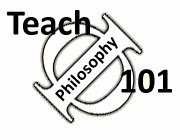Teach Philosophy 101
Free resources for
philosophy teachers!
"One of the most comprehensive, well-researched, and accessible guides for teachers that I have ever seen." James Lang, Chronicle of Higher Education (read full review of TΦ101)
Examples of Group Work
In this section, we focus primarily on in-class group work, rather than projects that are done outside of class. Please send us your own examples. Feel free to adapt any of these, but for your own protection, review our copyright and permissions section.
-
Three stay, one stray. In a large class there is not time for each group to report out what it has learned. This methodology, presented by Barbara Millis, allows for reporting without taking up a lot of class time.
-
North-South, East-West. A simple debate format, developed by Villanova student Paul Recupero. Class is divided into four groups, with two debate topics. Two groups (north and south) debate issue with assigned roles (pro or and con) and other groups comment, then second two groups debate with comments by the first two.
-
Identify Assumptions. Students -- especially those with a Christian background -- often think they already know what religious thinkers will say. This exercise, used in teaching Augustine's work, helps students identify what they think the religious view is, which then can be used as a contrast to what St. Augustine actually thinks. It can be easily generalized to other thinkers. Developed by John Immerwahr.
-
Using groups to discuss issues in Descartes' Meditations. Emrys Westacott (Alfred University) has developed a series of ingenious group exercises for students who are reading Descartes' Meditations. For example, to help students discuss the "piece of wax" example, he gives each student a stick of chewing gum, and asks the students to describe its characteristics before and after being chewed, and then to explain why they think it is the same object (all of the other exercises are equally inventive). "Interactive Meditations: Discussion Assignments in an Introductory Philosophy Class."
-
EEE methodology. This approach is due to David Braun, but something like this is employed in a variety of logic text books. Students work together to extract the main premises and the conclusion of an argument, supplying any implied or suppressed premises and removing any extraneous material. Then they put the argument into a valid form. Finally, they evaluate the argument, raising objections to at least one premise they identified. This takes a bit of set up: teaching students about premises and conclusions, as well as a handful of valid forms, but the pay off is worth while, as this is an activity that can happen every few class sessions with increasingly more complex arguments.
Updated: 11/25/2025--David Sackris
